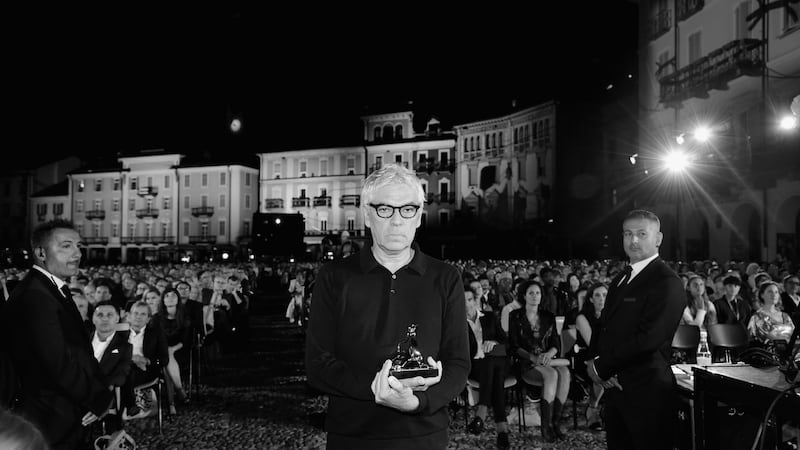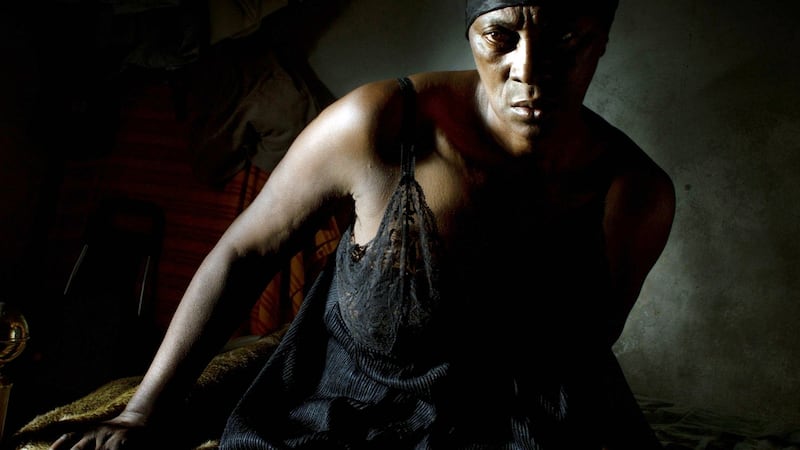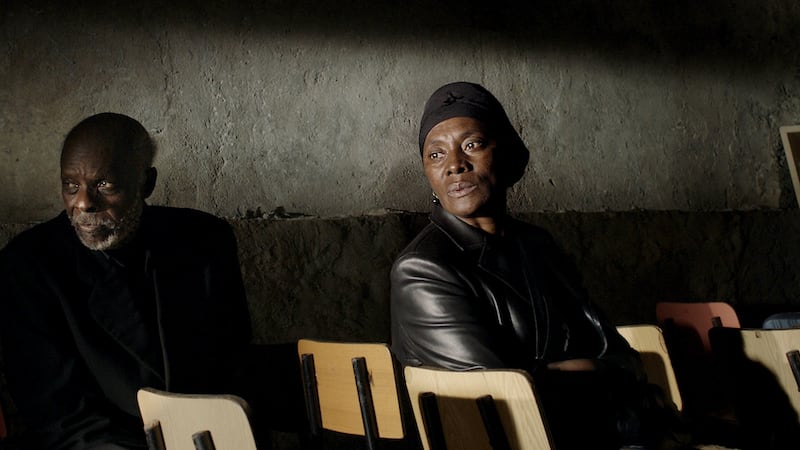Among contemporary film-makers, Pedro Costa comes closest to the cinema described by Paul Schrader in Transcendental Style in Film: Ozu, Bresson and Dreyer. Eschewing psychological realism for poetic reflection and phantasmagorical photography, he has fashioned a sui generis cinema that has won many admirers.
Catherine Breillat, president of the Locarno Film Festival jury, awarded Costa’s Vitalina Varela the top festival prize last year, promising “that [it] will enter the heritage of world cinema”.
“The work of Pedro Costa has progressed in slow, measured steps, but each step has been a giant leap,” wrote Cyril Neyrat for the Criterion Collection.
The Guardian’s Peter Bradshaw has called him the “Samuel Beckett of cinema.”
Costa is not so sure.
“I’m sorry but there are no Beckett in cinema,” he says. “Or Joyce, or Pessoa.”
The Portuguese auteur has, to date, presided over Casa de lava, a 1994 remake of Jacques Tourneur’s I Walked with a Zombie; change rien, a 2009 portrait of French actor and singer Jeanne Balibar; and Where Lies Your Hidden Smile?, a making-of documentary depicting Straub and Huillet in the editing suite for their 1999 feature Sicilia!, quarrelling over the five cuts per day they manage to agree upon. Critic Jonathan Rosenbaum called it “the best film ever made about film-making”.

Costa is best known, however, for films set in a dreamlike universe inspired by the Fontainhas, a now-demolished shantytown on the outskirts of Lisbon, and former home to many dispossessed Portuguese and struggling Cape Verdean immigrants.
It’s a quarter that the director was introduced to after he shot his second feature in Cape Verde. Returning to Lisbon, he was asked by islanders to deliver letters and presents to Cape Verdean immigrants in the suburbs, including those in Fontainhas.
“I was immediately accepted, I brought them news from their loved ones,” recalls Costa. “I never read those letters. I didn’t know if they brought bad or good news, love or hate. Sometimes I just stood there watching their faces, reading those letters. That became a turning point for me, I told myself: this is where it all begins, here we are face to face. I had the feeling that I couldn’t rob anything from anyone. At the same time, I couldn’t offer much. This was the deal. And it was very powerful. We could start from this common unknown.
“It became a sort of origin, or a new departure in film-making for me. I have to say that, at that time, I was losing faith in cinema and in myself; I was working with big crews and all the conventional circus. I kept thinking ‘if this is how films are made then I don’t want any part of it’. I knew I had to find some other way. I was a bit lucky, because we were at the dawn of the small video cameras. And I was saved by that neighbourhood, by the people.
“I was home, but I had to learn a new language – Creole – and this was already a wonderful feeling: the work had started and it seemed to me that was a bit more than just making a movie. I knew I was working in a very disturbed, very disoriented community: these people used to be peasants in Cape Verde, they migrated to Lisbon to work and in Portugal they were mercilessly exploited. I know we’d have to work amidst this distress and confusion. It’s very risky and challenging. But I have no interest in safe scenarios.”
Costa was born in Lisbon in 1958. He studied at Lisbon Theatre and Film School where he was a student of António Reis. He emerged at a vibrant moment for Portuguese cinema and quickly found work as an assistant director. His parents were journalists, a profession he connects with his turn-of-the-millennium shift away from big-budgeted narrative features toward ghostly films set in ghostly places populated by those ghosted by society.
“The importance or the interest or beauty of a film can also come from pure information,” he says. “If you’re a serious film-maker, if you are committed to this work in these places with this people, if you love your craft, then you’ll have to find your way and get really close and it goes both ways: inwards into their hearts and souls and into your own deep self. You’ll have to do your best and get to something that goes beyond all the cliches.”

Costa’s seventh feature – and fifth feature to incorporate documentary elements – is Vitalina Varela, a heartbreaking, hypnotic expansion of a sorrowful ethnofiction overheard in the director’s 2014 feature Horse Money. He met the heroine of the title during the earlier shoot.
“For Horse Money, I wanted to do some interior shots of people in their houses,” says Costa. “I wanted to do a musical sequence, but I couldn’t find any of those traditional houses, most of the people had already been relocated far off in social blocks. And then a friend told me to come to Cova da Moura, a different African neighbourhood, not far but not as nice as the old Fontainhas. He thought that there some houses I might like: ‘There’s this one, the owner just died, it’s has been closed since, maybe we can kick the door in’.
“As soon as he said it and pointed at the house, the door opened, and Vitalina came to the doorstep, all in black. I think the film was born in that moment: a voice whispering me that a man was dead and this apparition, a woman in mourning staring me in the eyes. That meeting was very powerful. And I had the immediate feeling that this film could last forever.”

Vitalina Tavares Varela had arrived five months earlier. She didn’t speak Portuguese and she didn’t have any papers. She had travelled to Lisbon to join her husband, who had left Cape Verde and their home village of Figueira das Naus in 1977. He died before she arrived in Portugal.
“Vitalina is a very lonely woman,” says Costa. “Even in her wedding photographs Vitalina is alone. She and her husband married by proxy: Vitalina was in Cape Verde in her wedding dress, Joaquim was in Lisbon. After the marriage, Joaquim went back to Cape Verde a couple of times, he got Vitalina pregnant twice, and in 2013 he died. Vitalina was done with Joaquim, that’s what she told me.
“And suddenly, something came over her, a clash between grief and fury: she’s devastated, mourning his death and at the same time she’s furious about this supreme act of cowardice. In a way, she wants to avenge herself: ’You coward can’t run away anymore! You have to tell me everything you never told me!’. And she waits and hopes for a sign. That’s why she took the plane and decided to stay in her husband’s house forever.
“What a strange decision. Why does she stay in Lisbon? Her heart and her mind are always back in her village, surrounded by the mountains, she’s always going back to her island, to her animals, to the wind on her face, to the sun. The war inside Vitalina is not over. I was moved by the story of her arrival flight to Lisbon. The simple fact that she wanted to share this pain gave me a lot of strength to start working on the possibility of an entire film with her.”

Costa’s process is fascinating. Working without the safety net of a script, storyboard, or professional actors, he finds his stars in the makeshift tin and brick huts of places like Cova da Mora. How difficult is it, I wonder, for an outsider to make friends and find collaborators in such a disenfranchised neighbourhood?
“You have to go inside the houses, talk to people,” he says. “Otherwise they wouldn’t reveal themselves. And to have the confidence that the so-called narrative, is anywhere and everywhere, between the walls of the houses and the words and gestures of people. I had the feeling that everything was already ‘rolling’ when I arrived in the morning: bar was open, people were working, an old women sweeping the alley, dogs barking, kids playing. It was a question of adjusting yourself to that reality.
“But it’s a broken community, oppressed, persecuted. Men, which used to represent 80 per cent of all immigrants, as soon as they arrived, they began to forget. The island, the wives, the children. They drink, they lose themselves. We’re trying to pick up the pieces of these men, trying to understand. And that place works because of women: the households, the economy of the neighbourhood, the kids, the information, most of it is ruled by women.
“Everybody must be convinced that you’re really interested. In turn, they’ll be seriously interested in the work. And it’s not a matter of money, vanity or whatever: it has to be because they see some purpose to cinema. My films are only possible because we meet and share a certain experience. Cinema must always be ready and willing to risk itself and be interested in going along with an unknown woman who leads you by the hand and says ‘Come see what happened to me’.”
For Vitalina herself, the production became a kind of mourning ritual. Costa listened to her memories of her runaway husband. During the shoot, they set up an altar with photographs of Joaquim surrounded candles. The director asked her to write letters to her husband and to imagine letters from him. Ritual is an important aspect of the film and Costa’s idea of the medium.
“Just the fact of preparing the small altar was very important because this society tends to forget,” says the film-maker. “It also told us something about keeping the flame of cinema burning. It’s something you should nourish and maintain during the whole shoot. You really have to be faithful to the very first reason you had to make it.
“I won’t deny it – it’s hard work. A kind of work with non-professional actors that I think still existed 20, 30 years ago and that has vanished completely. Maybe I’m not fair to some of my fellow film-makers, but I really think we lack and desperately need this work in film, today.”
Vitalina Varela is available to stream on Mubi


















